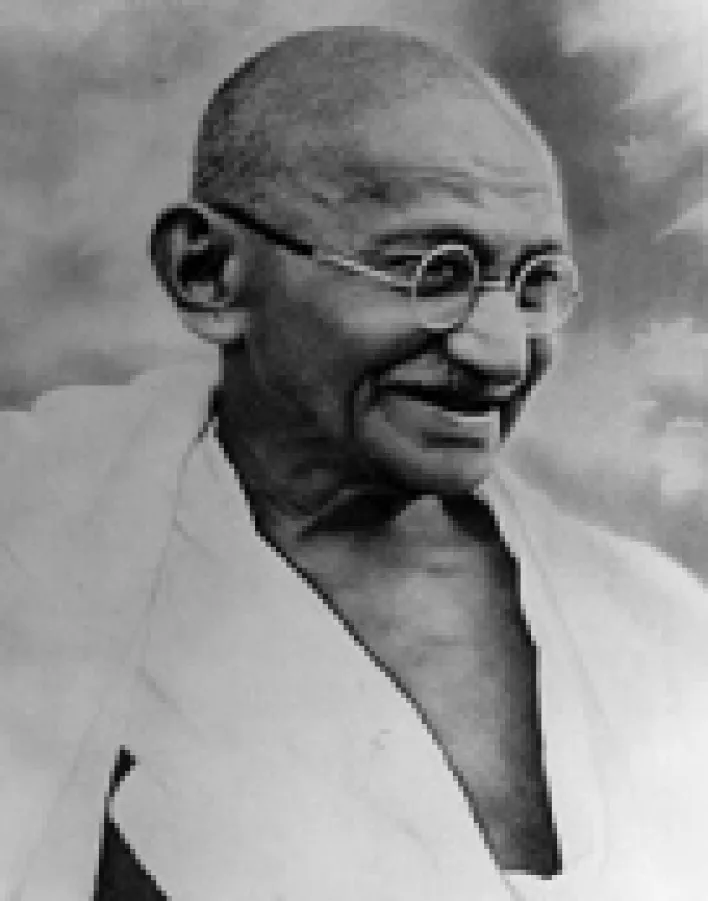
Where did the idea of a ’peace brigade’ come from?
The idea of an unarmed, nonviolent peace force comes from two different sources: the Quakers and Gandhi.

In 17th-century England, Quakers offered their services as mediators before or during conflicts. This practice was rooted in the Quaker belief that there is something of God in everybody, therefore, no-one should be debased, exploited or killed.
The second source is the philosophy and work of Gandhi. He trained groups in nonviolent protest and interpositioning in conflicts, beginning with his “peace army” in South Africa from 1911 until 1913. In protest against discrimination against Indians, several thousand women, later joined by men, marched illegally in order to get arrested and thereby raise public indignation against their imprisonment.
When he returned to India, Gandhi organised peace volunteers to mediate in riots in Bombay, calling them Shanti Sena (Peace Army or Peace Brigade). Their actions were based on the following principles: bear no arms, not even sticks, expect no remuneration, wear uniforms, accept voluntary self discipline, and practice nonviolence in thought, word and deed.
Gandhi believed that a group of neutral people, trained and ready to suffer abuses, injury or even death while acting to save lives, would have the moral authority to bring a sense of humanity to all sides in a conflict. This would eventually convince the opposing parties to seek an alternative solution. Gandhi began with no blueprint. He believed that a small body of determined people with a strong belief in their mission could alter the course of history.
The World Peace Brigade (WPB)
In 1962, after Gandhi’s death, a World Peace Brigade (WFB) was set up by Shanti Sena activists including Jayaprakash Narayan, a close associate of Gandhi, Michael Scott from Britain, noted for his work on African Liberation, and A.J.Muste, a veteran of nonviolent action from the US.
WPB sponsors included Julius Nyerere (then Prime Minister of Tanganika), and Kenneth Kaunda, who later became president of Zambia. From 1962-64 the WPB promoted nonviolence as part of African liberation struggles.
The WPB collapsed mainly because of difficulties of communication -in those pre-fax, pre-email days- and funding problems. As Charles Walker commented at the founding meeting of PBI: ’The problem of the World Peace Brigade was: money, money, money … very few things in the world are made better by lack of money.’
From 1964-1972, Shanti Sena were involved in helping to negotiate a ceasefire in the 10 year war between the Naga people and the Indian Government. They maintained observer teams in the region for the following six years..
In the 1971 crisis that led to the founding of Bangladesh, peace brigades played a variety of roles. From 1972-1974, the Cyprus Resettlement Project helped to resettle 5,000 Greek and 15,000 – 20,000 Turkish refugees who had fled their villages during fighting in 1963.
The next wave of peace brigade initiatives took off in the 1980s in Central America, with the independent founding of two new organisations: Peace Brigades International and Witness for Peace. Fuelled by the unprecedented world-wide solidarity movement with the poor of Central America and the simultaneous rapid expansion of the global human rights movement, these two organisations mobilised thousands of citizens from around the world in long-term peace presences in Nicaragua, Guatemala and El Salvador.
The effectiveness of these two efforts was based less on the idea of peace brigades as an activist intervention playing an active role in a conflict, but more on taking advantage of the political power inherent in the presence of foreign nationals in a conflict zone. The new organizations also took advantage of the growing impact of international education and non-governmental lobbying on international conflict and human rights abuses. The combined impact became known as “protective accompaniment.”
Largely due to PBI’s work and success, accompaniment has now been embraced by the international human rights community, because it has proven effective where other international human rights mechanisms have failed. In an international conference on protection of human rights defenders, organised by Amnesty International and held in Colombia, it was concluded that international accompaniment is one of the relevant tools for protection of human rights defenders on the ground. It has also been embraced by various solidarity movements. Unlike more activist efforts, accompaniment minimises outside interference, and strengthens the self-determination and confidence of local organizations rather than implicitly replacing them.
